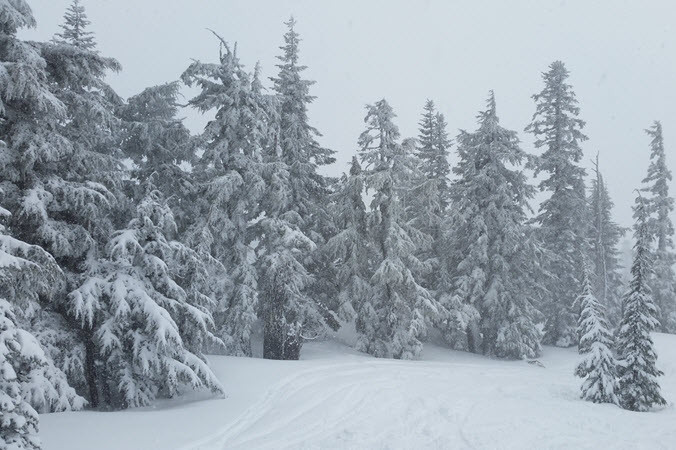Almost nothing went according right the first time Drew Rupp went splitboarding at
White River Sno Park (opens in new window) near Mount Hood.
Rupp's trekking poles broke—he couldn't shorten or elongate the poles, which made it difficult to navigate varying levels of snowpack—and the board he used hadn't been waxed ahead of time, turning the casual outing into a frustrating slog. But, for all the difficulties, Rupp, a sales associate with
Next Adventure and guide for the company's Outdoor School program, fell in love with the chance to see backcountry scenery in a whole new way.
"It was one of the best trips I ever did," Rupp says. "I got to do something I'd never done before. I always wanted to see what was on the other side of that ridge, but I never got that chance. Once I finally did, it hooked me."
 Splitboarding opens up a whole new world of outdoor exploration - Gergely Csatari.
Splitboarding opens up a whole new world of outdoor exploration - Gergely Csatari.
For Rupp, the appeal of splitboarding lies in the freedom that comes with backcountry exploration. Splitboarding—in which boarders use two ski-like halves of a detachable snowboard to ascend a slope or trail before reassembling the board, putting the trekking poles in their backpack, and snowboarding back down—blends cross-country skiing and snowboarding to give adventurers additional freedom. The sport debuted in the mid-1990s and quickly latched on with snowboarders and skiers hungry to explore new terrain.
"Some people are tired of waiting in line at the resorts, so they want to go explore other places," Rupp says. “The biggest appeal for me is, on a good powder day, there’s a good chance you might not see someone all day long."
So, you want to give splitboarding a go? Here's what you need to know.
1. You Must place a high priority on staying safe.

He's quick to admit that freedom is also tied to the most important lesson a splitboarder should know before trying the sport: Safety is paramount. Given that splitboarders generally blaze their own trails in the backcountry, it's easy to get lost or caught in an avalanche. To that end, Rupp recommends that all splitboarders have prior backcountry experience, and to go with someone who's familiar with the sport, before setting out on their own.
He also advises all would-be splitboarders to receive some kind of avalanche training before heading out. The American Institute for Avalanche Research and Education (AIARE) offers
numerous public training sessions throughout Oregon (opens in new window) this winter, though most are in Central Oregon. (Training sessions will be offered on Mount Hood in January and February.) The AIARE's training goes over a litany of important avalanche-related issues, including how to spot (and avoid) dangerous slopes, what to do if a slope slides, and how to perform a rescue.
Rupp also cites
Avalanche.org (opens in new window) as an essential resource; the website provides snowpack updates and avalanche warnings for slopes throughout the United States. “Whether you’re a snowboarder, skier, splitboarder, or hiker, having that knowledge is crucial.”
2. Prepare to shell out some cash to get started.
Second, Rupp encourages splitboarders to be outfitted with the proper gear. Boards usually run between $400 and $800 and come in various shapes that cater to different backcountry experiences; some, with long noses, are ideal for freestyle and powder, while others come with a broader nose best suited for deep powder. Boarders should choose gear that best allows them to glide over the snow, rather than take long, cumbersome steps.
Rupp also recommends a pair of trekking poles to make the ascent more bearable, as well as boots, bindings, and a backpack.
Boarders should also hit the slopes armed with what Rupp calls the "three essentials": a probe, shovel, and beacon for difficult conditions. "If someone gets buried, those are what will get you un-buried or your buddy un-buried," Rupp says.
3. Ready to shred? Here's where to go.

Rupp is quick to shout out the expansive backcountry terrain surrounding nearby Cascade volcanoes, including Mount Hood and Mount Rainier. Rupp is also fond of Mirror Lake (popular with snow-shoers, hikers, and fat bike fans), which offers a casual ascent and a south-facing hill—both ideal for newbie splitboarders.
Boarders looking for other destinations would do well to visit
Splitboard Oregon, which offers trip reports full of photos, tips, and other useful knowledge.
And while he's happy to evangelize about the sport and the unusual opportunities it offers, Rupp also emphasizes the importance of being educated before hitting the slopes. Next Adventure will offer free presentations and clinics on backcountry basics this winter, and he stresses that first-time splitboarders go with someone they trust. "Being educated is the number one thing you can do for yourself," he says. "Without that, things can go terribly wrong."
Written by Matt Wastradowski for RootsRated and legally licensed through the Matcha publisher network.
Recent Posts:
New England’s Gnarliest Ski Runs.
An Insider’s Take on Skiing Mt. Baker.
Jackson Hole: What to Know, Where to Go.

